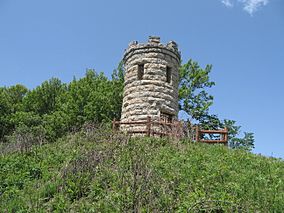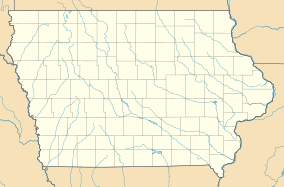Mines of Spain State Recreation Area and E. B. Lyons Nature Center facts for kids
Quick facts for kids Mines of Spain State Recreation Area and E. B. Lyons Nature Center |
|
|---|---|

Julien Dubuque's monument
|
|
| Location | Dubuque, Iowa, United States |
| Area | 1,380 acres (5.6 km2) |
| Elevation | 751 ft (229 m) |
| Established | 1981 |
| Named for | Julien Dubuque's Mines |
| Governing body | Iowa Department of Natural Resources |
|
Julien Dubuque's Mines
|
|
| Built | 1897 |
| Architect | Alexander Simplot; Carter Bros. |
| Architectural style | Late Gothic Revival |
| MPS | Mines of Spain Archeological MPS |
| NRHP reference No. | 88002662 |
| Significant dates | |
| Added to NRHP | November 21, 1988 |
| Designated NHLD | November 04, 1993 |
The Mines of Spain State Recreation Area and E. B. Lyons Nature Center is a fun state park in Dubuque County, Iowa. It's located close to the city of Dubuque. This park is a great place to explore nature and history.
You can enjoy many activities here, like picnics and hiking. There are about 15 miles (24 km) of walking trails and 4 miles (6.4 km) of ski trails for winter fun. Don't miss the beautiful Betty Hauptli Bird and Butterfly Garden!
The park is also home to important historical sites. These include places where a French explorer named Julien Dubuque mined lead a long time ago. His gravesite is also here. These special spots are so important that they are called a National Historic Landmark District.
Contents
Exploring the Park's History
The Mines of Spain area has a very long and interesting history. People have lived here for thousands of years!
Early People and Their Lives
The first known people lived here during the Late Archaic period, from about 2050 BCE to 450 BCE. They started to settle down in one place more often. We know they traded with others because copper from the Lake Superior area has been found here.
Archaeologists have found many tools and signs of these early groups. They also found galena, a type of lead ore, which was used in special burial ceremonies.
Later, during the Woodland period (450 BCE to 1250 CE), people made pottery and built burial mounds. They also started growing plants for food. This led to the Oneota period (950 CE until Europeans arrived). The Oneota people grew crops, but also hunted and gathered food. They used tools like hoes made from bison bones and stones for grinding grain.
The Meskwaki Tribe
The Meskwaki tribe arrived in this area around the 1760s or 1780s. They had moved here after being pushed from other places, like Michigan and Wisconsin.
The Meskwaki mainly grew crops and hunted for food. They also fished and gathered wild plants. Over time, they became involved in the fur trade. They lived in villages with wooden fences, called palisades. Sometimes, families would move to smaller camps for hunting.
The Meskwaki also started mining lead. This was a way to get goods for trading. Only a few people, mainly women and older men, did the mining. They dug for lead close to the surface. Then, they would heat the ore to get the lead out, using simple furnaces. They traded this lead with nearby traders or took it to places like St. Louis.
Julien Dubuque and the Mines of Spain
In 1788, a French explorer named Julien Dubuque made an agreement with the Meskwaki to mine lead. He is thought to be the first European to settle in what is now Iowa.
The Spanish government, who owned the land at the time, gave Dubuque permission to work the mines. They named the 1,380-acre (560 ha) area "The Mines of Spain."
Dubuque set up a trading post near a Meskwaki village along Catfish Creek. This post had his home, houses for workers, a mill for grain, and storage for furs. He traded lead and furs with the Meskwaki and other tribes, sending goods to distant cities.
People continued to mine lead here until 1914. All these activities left behind many important archaeological sites. These include old Native American villages, Dubuque's trading post, and the mining areas. These sites are now protected as historic districts. They were all recognized as a National Historic Landmark District in 1993.
The Julien Dubuque Monument
Julien Dubuque passed away in 1810. He was buried following the customs of the Meskwaki tribe.
In 1897, leaders from the City of Dubuque decided to build a monument for him. They saw him as the founder of their city. This happened when the city wanted to boost its image and economy.
When they dug for the monument's foundation, human remains were found. However, it's not certain if this was exactly where Dubuque, his wife Potosa, and her father Peosta (a Meskwaki chief) were buried. The monument is important because it shows how the community wanted to honor its past.
The monument is a round stone tower. It stands about 25 feet (7.6 m) tall and 12 feet (3.7 m) wide. It's made from local limestone and has no roof. The tower has narrow windows and a metal gate at its entrance. A bronze plaque on it reads: "Julien Dubuque. Miner of the Mines of Spain. Founder of Our City. Died March 24, 1810."
The monument was designed to look like something from the medieval times. It has a special top called crenellations, which look like the tops of old castles. It sits on a bluff overlooking Catfish Creek where it meets the Mississippi River.
What You Can See at the Park
The park offers unique natural sights. From a horseshoe-shaped area called Horseshoe Bluff, you can see the interesting rock layers of the area. These rocks are called Ordovician dolomite. Two trails lead to a blind, where you might be able to watch wildlife.




